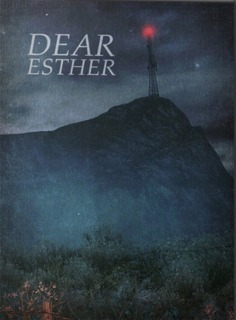It's not a game, it's interactive art.
There is also a story, of course, one that is beautifully executed in its ambiguity. Random fragments of the tale are given through the narrator's speech, leaving you to piece together the different events and characters described and draw your own conclusions. It's a very unique and interesting tale, describing everything from the history of the island you are on to events from the character's life, drawing everything together. The delivery is exceptional, giving the metaphorical speeches a deeper impact when spoken. The soundtrack is equally phenomenal and memorable, setting the tone for the adventure. It is especially fitting when backing up the speeches given by the narrator.
As I have said before, Dear Esther isn't really a "game". You spend the whole 2 or so hours slowly lumbering around an island. Now let me warn you that your character is slow. Really slow. And there is only one speed on him, so be prepared to enjoy the scenery on the way back if you headed off in the wrong direction for a while. This is the biggest annoyance I have had with "Dear Esther", it is just too slow. I can think of several ways the process could have been sped up without sacrificing the atmosphere. There could have been an intense sprint you could execute at certain moments, where the view shakes, the outside world becomes quieter, and some subtle music kicks in. How about that for a dramatic effect? That isn't the only thing wrong on the island however. Sometimes the landscape is a bit too confusing and open. At one point, I decided to slide down a cliff side to investigate a stream, which really threw me off later. I assumed that since you were allowed to descend there, since I was frequently met with player clips, or "invisible walls", it was simply a branching path that you could explore at your leisure, but it was actually the path to the next part of the island, and every time I got near it I thought I was backtracking. The movement speed didn't make this confusion any more enjoyable.
If you have seen even a glimpse of Dear Esther, you already know it looks astonishing. The Source engine isn't getting any younger, but Robert Briscoe still knows how to make it shine. I was blown away by what he had managed to accomplish with the nearly 8-year-old engine. The waves, the foliage, the atmosphere, the caustics, everything that he managed to implement into Dear Esther never ceased to amaze me. As someone with a fair amount of experience with the engine, I know that making a rich and beautiful island like that isn't easy with a map editor that revolves around basic brush and entity work. Most developers have access to much newer engines, with much more streamlined tools that can do most of their work procedurally, yet this one guy outdoes them all. If an entire team spent half as much time and effort as this one guy did on Dear Esther, the industry might only be half as stale.
Dear Esther is an incredible experience, worthy of multiple playthroughs. I guarantee you it isn't like anything you have experienced before. It's story, music, and landscape will stay with you long after you have stopped playing. It isn't without its drawbacks, and it's short length may not justify its $10 price tag, but hey, it's an experiment, and I would say it was still pretty successful in the end.

